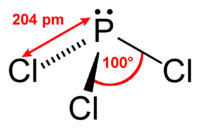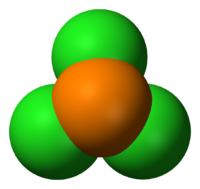- Phosphorus trichloride
-
Phosphorus trichloride 

 Phosphorus trichlorideOther namesPhosphorus(III) chloride
Phosphorus trichlorideOther namesPhosphorus(III) chloride
Phosphorous chlorideIdentifiers CAS number 7719-12-2 
PubChem 24387 ChemSpider 22798 
EC number 231-749-3 UN number 1809 ChEBI CHEBI:30334 
RTECS number TH3675000 Jmol-3D images Image 1 - ClP(Cl)Cl
Properties Molecular formula PCl3 Molar mass 137.33 g/mol Appearance colourless liquid Density 1.574 g/cm3 Melting point -93.6 °C (179.6 K)
Boiling point 76.1 °C (349.3 K)
Solubility in water hydrolysis Solubility in other solvents soluble in benzene, CS2, ether, chloroform, halogenated organic solvents Refractive index (nD) 1.516 (14 °C) Dipole moment 0.97 D Thermochemistry Std enthalpy of
formation ΔfHo298−319.7 kJ/mol Hazards MSDS External MSDS EU Index 015-007-00-4 EU classification Toxic (T)
Harmful (Xn)
Corrosive (C)R-phrases R14, R26/28, R35, R48/20 S-phrases (S1/2), S7/8, S26, S36/37/39, S45 NFPA 704 LD50 550 mg/kg Related compounds Related phosphorus chlorides Phosphorus pentachloride
Phosphorus oxychloride
Diphosphorus tetrachlorideRelated compounds Phosphorus trifluoride
Phosphorus tribromide
Phosphorus triiodideSupplementary data page Structure and
propertiesn, εr, etc. Thermodynamic
dataPhase behaviour
Solid, liquid, gasSpectral data UV, IR, NMR, MS  trichloride (verify) (what is:
trichloride (verify) (what is:  /
/ ?)
?)
Except where noted otherwise, data are given for materials in their standard state (at 25 °C, 100 kPa)Infobox references Phosphorus trichloride is a chemical compound of phosphorus and chlorine, having chemical formula PCl3. Its shape is trigonal pyramidal. It is the most important of the three phosphorus chlorides. It is an important industrial chemical, being used for the manufacture of organophosphorus compounds for a wide variety of applications. It has a 31P NMR signal at around +220 ppm.
Contents
Chemical properties
The phosphorus in PCl3 is often considered to have the +3 oxidation state and the chlorine atoms are considered to be in the −1 oxidation state. Most of its reactivity is consistent with this description.
Redox reactions
PCl3 is a precursor to other phosphorus compounds, undergoing oxidation to phosphorus pentachloride (PCl5), thiophosphoryl chloride (PSCl3), or phosphorus oxychloride (POCl3).
If an electric discharge is passed through a mixture of PCl3 vapour and hydrogen gas, a rare chloride of phosphorus is formed, diphosphorus tetrachloride (P2Cl4).
PCl3 as an electrophile
Phosphorus trichloride is the precursor to organophosphorus compounds that contain one or more P(III) atoms, most notably phosphites and phosphonates. These compounds do not usually contain the chlorine atoms found in PCl3.
PCl3 reacts rapidly and exothermically with water to form phosphorous acid, H3PO3 and HCl:
- PCl3 + 3 H2O → H3PO3 + 3 HCl
A large number of similar substitution reactions are known, the most important of which is the formation of phosphite esters by reaction with alcohols or phenols. For example, with phenol, triphenyl phosphite is formed:
- 3 PhOH + PCl3 → P(OPh)3 + 3 HCl
where "Ph" stands for phenyl group, -C6H5. Alcohols such as ethanol react similarly in the presence of a base such as a tertiary amine:[1]
- PCl3 + 3 EtOH + 3 R3N → P(OEt)3 + 3 R3NH+Cl−
Of the many related compounds can be prepared similarly, triisopropyl phosphite is an example (b.p. 43.5 °C/1.0 mm; CAS# 116-17-6).
In the absence of base, however, the reaction produces phosphonic acid and an alkyl chloride, according to the following stoichiometry:
- PCl3 + 3 C2H5OH → 3 C2H5Cl + H3PO3[2]
Alternatively, under certain conditions the dialkyl phosphonate (dialkyl phosphite) may be isolated, as well as some alkyl chloride:[3]
- PCl3 + 3 iPrOH → iPr2PH=O + iPrCl + 2 HCl(g) where iPr = isopropyl, (CH3)2CH-
Amines, R2NH, form P(NR2)3, and thiols (RSH) form P(SR)3. An industrially relevant reaction of PCl3 with amines is phosphonomethylation, which employs formaldehyde:
- R2NH + PCl3 + CH2O → (HO)2P(O)CH2NR2 + 3 HCl
Aminophosphonates are widely used as sequestring and antiscale agents in water treatment. The large volume herbicide glyphosate is also produced this way. The reaction of PCl3 with Grignard reagents and organolithium reagents is a useful method for the preparation of organic phosphines with the formula R3P (sometimes called phosphanes) such as triphenylphosphine, Ph3P.
- 3 PhMgBr + PCl3 → Ph3P + 3 MgBrCl
Under controlled conditions PCl3 can be used to prepare PhPCl2 and Ph2PCl.
PCl3 as a nucleophile
Phosphorus trichloride has a lone pair, and therefore can act as a Lewis base, for example with the Lewis acids BBr3[4] it forms a 1:1 adduct, Br3B−−+PCl3. Metal complexes such as Ni(PCl3)4 are known. This Lewis basicity is exploited in one useful route to organophosphorus compounds using an alkyl chloride and aluminium chloride:
- PCl3 + RCl + AlCl3 → RPCl+
3 + AlCl−
4
The RPCl+
3 product can then be decomposed with water to produce an alkylphosphonic dichloride RP(=O)Cl2.Preparation
World production exceeds one-third of a million tonnes.[5] Phosphorus trichloride is prepared industrially by the reaction of chlorine with a refluxing solution of white phosphorus in phosphorus trichloride, with continuous removal of PCl3 as it is formed.
- P4 + 6 Cl2 → 4 PCl3
Industrial production of phosphorus trichloride is controlled under the Chemical Weapons Convention, where it is listed in schedule 3. In the laboratory it may be more convenient to use the less toxic red phosphorus.[6] It is sufficiently inexpensive that it would not be synthesized for laboratory use.
Uses
PCl3 is important indirectly as a precursor to PCl5, POCl3 and PSCl3. which in turn enjoy many applications in herbicides, insecticides, plasticisers, oil additives, and flame retardants.
For example oxidation of PCl3 gives POCl3, which is used for the manufacture of triphenyl phosphate and tricresyl phosphate, which find application as flame retardants and plasticisers for PVC. They are also used to make insecticides such as diazinon. Phosphonates include the herbicide glyphosate.
PCl3 is the precursor to triphenylphosphine for the Wittig reaction, and phosphite esters which may be used as industrial intermediates, or used in the Horner-Wadsworth-Emmons reaction, both important methods for making alkenes. It can be used to make trioctylphosphine oxide (TOPO), used as an extraction agent, although TOPO is usually made via the corresponding phosphine.
PCl3 is also used directly as a reagent in organic synthesis. It is used to convert primary and secondary alcohols into alkyl chlorides, or carboxylic acids into acyl chlorides, although thionyl chloride generally gives better yields than PCl3.[7]
Precautions
PCl3 is toxic, with a concentration of 600 ppm being lethal in just a few minutes.[8] PCl3 is classified as very toxic and corrosive under EU Directive 67/548/EEC, and the risk phrases R14, R26/28, R35 and R48/20 are obligatory.
References
- ^ A. H. Ford-Moore and B. J. Perry (1963), "Triethyl Phosphite", Org. Synth., http://www.orgsyn.org/orgsyn/orgsyn/prepContent.asp?prep=CV4P0955; Coll. Vol. 4: 955
- ^ Clark, Jim (2008). Replacing the OH in alcohols by a halogen. Retrieved October 9, 2008.
- ^ Pedrosa, Leandro (2011). "Esterification of Phosphorus Trichloride with Alcohols; Diisopropyl phosphonate". ChemSpider Synthetic Pages (Royal Society of Chemistry): 488. doi:10.1039/SP488. http://cssp.chemspider.com/488.
- ^ R. R. Holmes (1960). "An examination of the basic nature of the trihalides of phosphorus, arsenic and antimony,". Journal of Inorganic and Nuclear Chemistry 12 (3-4): 266–275. doi:10.1016/0022-1902(60)80372-7.
- ^ Greenwood, Norman N.; Earnshaw, Alan (1997). Chemistry of the Elements (2nd ed.). Oxford: Butterworth-Heinemann. ISBN 0080379419.
- ^ M. C. Forbes, C. A. Roswell, R. N. Maxson (1946). "Phosphorus(III) Chloride". Inorg. Synth. 2: 145–7. doi:10.1002/9780470132333.ch42.
- ^ L. G. Wade, Jr., Organic Chemistry, 6th ed., p. 477, Pearson/Prentice Hall, Upper Saddle River, New Jersey, USA, 2005.
- ^ A. D. F. Toy, The Chemistry of Phosphorus, Pergamon Press, Oxford, UK, 1973.
Phosphorus compounds Categories:- Inorganic phosphorus compounds
- Phosphorus halides
- Chlorides
- Nonmetal halides
Wikimedia Foundation. 2010.

